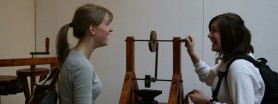
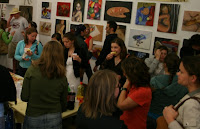 It wasn’t a Parisian but rather a Perugian vernissage on Tuesday as Umbra fine arts students had a chance to show off their semester’s work. The vernissage took place in Umbra’s Via Danzetta art studio, where the walls of every room but the darkroom were hung with paintings, drawings, and photographs. Students displayed their oil paintings, charcoal and pencil drawings (among them some huge, Benetton-like faces looming from far above the floor), and a mixture of playful and serious black-and-white photographs, some even hand-tinted. Umbra’s fine art faculty, many members of the staff, and most of the student body came during the course of the two-hour show.
It wasn’t a Parisian but rather a Perugian vernissage on Tuesday as Umbra fine arts students had a chance to show off their semester’s work. The vernissage took place in Umbra’s Via Danzetta art studio, where the walls of every room but the darkroom were hung with paintings, drawings, and photographs. Students displayed their oil paintings, charcoal and pencil drawings (among them some huge, Benetton-like faces looming from far above the floor), and a mixture of playful and serious black-and-white photographs, some even hand-tinted. Umbra’s fine art faculty, many members of the staff, and most of the student body came during the course of the two-hour show.
Category: Umbra Blog
This blog documents the experiences of students currently studying at the Umbra Institute in Perugia, Italy, offering an account of their day-to-day experiences, extra- and co-curricular activities, and special events. We hope you gain some insight into what adventures Umbra students find outside the classroom during their semester in Perugia, a medieval town in the mountains of Umbria. Cheers!
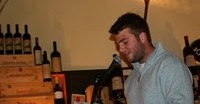 A record-breaking number of students showed up at La Tana del Orso for the semesterly Literary Reading for Professor Cindy Clough’s Creative Writing class. They crowded into Via Ulisse Rocchi prior to the 7:30 event, many worried that the televised sporting event that had been pushed forward to 5:30 would not end in time for the popular bar to accommodate the crowd. Wondrously, however, the room cleared punctually and tables filled instantly with Umbra students, staff, faculty and even a few visiting parents.
A record-breaking number of students showed up at La Tana del Orso for the semesterly Literary Reading for Professor Cindy Clough’s Creative Writing class. They crowded into Via Ulisse Rocchi prior to the 7:30 event, many worried that the televised sporting event that had been pushed forward to 5:30 would not end in time for the popular bar to accommodate the crowd. Wondrously, however, the room cleared punctually and tables filled instantly with Umbra students, staff, faculty and even a few visiting parents.
Creative Writing professor, Cindy Clough, reminded students that the “rhetorical situation” of La Tana was unique and certainly different from that of the student literary magazine; they could pull out their riskier pieces in an atmosphere of 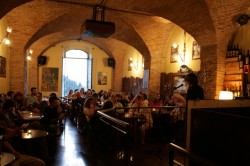 fun. Food seemed to be on everyone’s mind; students produced essay after essay on culinary experiences while waiting for La Tana staff to do some kind of loaves and fishes trick for the hungry unexpected multitudes. Beth Dudek, whose parents were visiting, dared to go first with her panegyric to Nutella and Jackie Starner followed suit, describing thedubious discovery that Nutella could be used even as a facial mask. Geno McDermott had everyone in stitches with his ribald caricature of Parma sandwich eaters. As the night progressed, the readings took a more pensive turn with Dan Gillespie’s reflections on Hugo Van der Goes Portinari Altarpiece and Paul Schiller’s narrative of travels with a kindhearted Sicilian who sang Madonna songs. No one was exempt from sharing something s/he had written during the term, but there were no shrinking violets: Everyone grabbed the mic with gusto and all had a rollicking good time.
fun. Food seemed to be on everyone’s mind; students produced essay after essay on culinary experiences while waiting for La Tana staff to do some kind of loaves and fishes trick for the hungry unexpected multitudes. Beth Dudek, whose parents were visiting, dared to go first with her panegyric to Nutella and Jackie Starner followed suit, describing thedubious discovery that Nutella could be used even as a facial mask. Geno McDermott had everyone in stitches with his ribald caricature of Parma sandwich eaters. As the night progressed, the readings took a more pensive turn with Dan Gillespie’s reflections on Hugo Van der Goes Portinari Altarpiece and Paul Schiller’s narrative of travels with a kindhearted Sicilian who sang Madonna songs. No one was exempt from sharing something s/he had written during the term, but there were no shrinking violets: Everyone grabbed the mic with gusto and all had a rollicking good time.
The Tana reading offers Umbra students not only a chance to share stories of their fondest study-abroad memories, but is also the first of many end-of-term celebrations.
 The semester’s almost over but the learning isn’t! This past Monday Umbra students were treated to a trip to a nearby Umbrian town, Bevagna. Bevagna is particular not so much for its beautiful boulevards or works of art, but rather for its preservation not just of buildings but of what was in them. Traditional crafts from as far back as the early Middle Ages
The semester’s almost over but the learning isn’t! This past Monday Umbra students were treated to a trip to a nearby Umbrian town, Bevagna. Bevagna is particular not so much for its beautiful boulevards or works of art, but rather for its preservation not just of buildings but of what was in them. Traditional crafts from as far back as the early Middle Ages are still practiced in Bevagna. Students witnessed demonstrations of paper and candle-making as well as silk spinning and a recreation of a medieval painter’s house and workshop. The weather was beautiful and warm and the students and staff were able to finish off the morning with a picnic lunch in a park-like atmosphere.
are still practiced in Bevagna. Students witnessed demonstrations of paper and candle-making as well as silk spinning and a recreation of a medieval painter’s house and workshop. The weather was beautiful and warm and the students and staff were able to finish off the morning with a picnic lunch in a park-like atmosphere.
 We often hear of alumni reunions held across the country – but we rarely receive photographic evidence. Rachel Bethany and Reid Williamson sent the following photos of an informal alumni reunion in Boston. These former Umbra students headed for Boston’s historic North End, a bastion of Italian eateries and culture, to share memories of their semester in Perugia.
We often hear of alumni reunions held across the country – but we rarely receive photographic evidence. Rachel Bethany and Reid Williamson sent the following photos of an informal alumni reunion in Boston. These former Umbra students headed for Boston’s historic North End, a bastion of Italian eateries and culture, to share memories of their semester in Perugia.
Alumni: please send your updates (and photos!) to [email protected].
 “Is the Pope Catholic?” is a sarcastic response to what seems to be a rhetorical question, but the answer to the question “How Catholic is Italy?” is not quite so obvious. In Professor Jim Schwarten’s Contemporary Italian Culture and Society, students attempted to answer just that question by compiling a questionnaire to poll Italians about Catholicism. The actual administration of the survey to Italians around Perugia gave the class members a chance to use their language skills, and approach members of the community. The results were very interesting.
“Is the Pope Catholic?” is a sarcastic response to what seems to be a rhetorical question, but the answer to the question “How Catholic is Italy?” is not quite so obvious. In Professor Jim Schwarten’s Contemporary Italian Culture and Society, students attempted to answer just that question by compiling a questionnaire to poll Italians about Catholicism. The actual administration of the survey to Italians around Perugia gave the class members a chance to use their language skills, and approach members of the community. The results were very interesting.
.jpg)
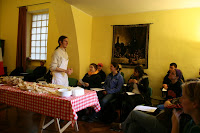 Leavening wasn’t the only topic yesterday during the Bread & Pasta Workshop, part of Professor Peter Fischer’s Food Cultures course. The workshop – one in a series of three – makes for a more hands-on academic course. Students learned about the history and biochemistry of bread, pasta, and other grain products. The hands-on part of the workshop included different doughs and even a thoroughly-sticky
Leavening wasn’t the only topic yesterday during the Bread & Pasta Workshop, part of Professor Peter Fischer’s Food Cultures course. The workshop – one in a series of three – makes for a more hands-on academic course. Students learned about the history and biochemistry of bread, pasta, and other grain products. The hands-on part of the workshop included different doughs and even a thoroughly-sticky lump of gluten, while the tasting part, less sticky and more pleasing to the palate, consisted of a variety of breads.
lump of gluten, while the tasting part, less sticky and more pleasing to the palate, consisted of a variety of breads.
First up were the unleavened gyro bread and the famous Sardinian “pane carasau,” a millennia-old shepherd’s bread. The students also tried the old Umbrian standby, torta al testo, a low bread traditionally cooked on a round piece of stone, the testo. Next came salted bread cooked in a wood-fired oven, along with the Italian standard, pizza. Professor Fischer’s students not only got an earfull, they got a stomach-full!
 After almost three months of weekly Wednesday Tandem meetings, attendance is still high. Last night a great group of Italian and Umbra students met to enjoy a nice buffet of pizza and pasta, at a local dive the Zibaldone.
After almost three months of weekly Wednesday Tandem meetings, attendance is still high. Last night a great group of Italian and Umbra students met to enjoy a nice buffet of pizza and pasta, at a local dive the Zibaldone.
While in Zibaldone, you’re surrounded by big ancient stones in a sort of medieval underground cave. With the mix of languages, it seemed almost as if we were in a Babel of Italian and English words floating in the air in any direction.
Though it was the last official Tandem meeting for the semester, Umbra students will continue to meet the Italians on their own. Another last reunion will be at the farewell dinner at the end of April.
Tandem will resume in the summer, again providing students with the opportunity to meet Italians under the Umbrian sun.
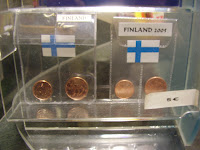 Finland, a place of oddities and wonders, and the beginning of my spring break. While in Helsinki, the capital of Finland, I saw many a thing, but only a few are noteworthy. First and foremost, it is a city similar to Milan or Trieste, full of new life, new buildings and stores. It has large department stores and huge malls. The best story about Finland though, lies in its most trivial of places, the tourist shops. Unlike most big cities, Helsinki does not have a booming tourism industry, but there are a few shops here and there.
Finland, a place of oddities and wonders, and the beginning of my spring break. While in Helsinki, the capital of Finland, I saw many a thing, but only a few are noteworthy. First and foremost, it is a city similar to Milan or Trieste, full of new life, new buildings and stores. It has large department stores and huge malls. The best story about Finland though, lies in its most trivial of places, the tourist shops. Unlike most big cities, Helsinki does not have a booming tourism industry, but there are a few shops here and there.
Finland, as is well known, is on the euro, but unlike other places they do not use the one or two cent coins. Instead, at each tourist shop and airport, they put these in little bags together and sell them for 3, 5, or even 8 euros. (in photo at left) What a country! Finland is a strange place and because of some disheartening events I will most likely choose not to return.
Leaving Finland, I went on to my final destination of Istanbul, once called Constantinople. This fantastic place is worth at least four or five days. They have many large beautiful mosques such as the Blue Mosque (in photo below) or Aya Sofia, and many fun museums too. They even have a royal palace that is filled with glitter and amusement, but the best part of Istanbul is their wondrous Grand Bazaar. The Grand Bazaar is one of the most interesting and fun places I have ever experienced. I felt like royalty as every merchant and business man approached me with an offer of some sort, ready to drop the price much lower than expected. It is a game, a constant game of wits and skill. Will they win and fleece you of a few extra dollars? Or will they get desperate and anxious enough to sell it to you for less than they had intended?
After going through the sixty-five streets of numerous goods ranging from clothes and normal items to marvelous chess sets and seemingly priceless artifacts, I took a Turkish Bath. This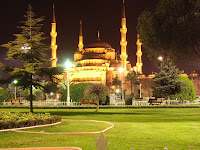 is the other must-have experience of Istanbul, a process of the best massages, saunas, steam rooms, and scrub downs that left me feeling entirely refreshed and ready to do anything. Every muscle in my body was relaxed. So I left the Turkish Bath with a smile on my face and headed over to a candy store to have some Turkish delights such as Lokum and then some baklava. These are the treasures of Istanbul and the joys of my spring break.
is the other must-have experience of Istanbul, a process of the best massages, saunas, steam rooms, and scrub downs that left me feeling entirely refreshed and ready to do anything. Every muscle in my body was relaxed. So I left the Turkish Bath with a smile on my face and headed over to a candy store to have some Turkish delights such as Lokum and then some baklava. These are the treasures of Istanbul and the joys of my spring break.
Blog and photos by: Dashiell Davis
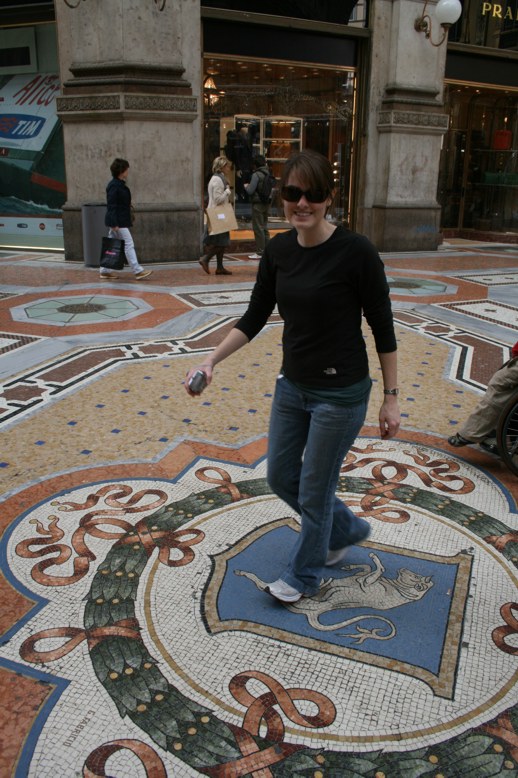 This weekend the Leonardo da Vinci class went on an exciting trip to Florence and Milan in order to get a closer look at several of Leonardo’s works. Friday, the brave Mauro Renna and Academic Director Dr. Carol Clark escorted the class of eighteen to Florence at 6am in the morning. Naturally, being college kids, we were all on time and ready for the day ahead. Upon our arrival in Florence we met up with Dr. Kwakkelstein and headed over to the Galleria degli Uffizi where we were able to appreciate Leonardo’s Adoration of the Magi and Baptism of Christ.
This weekend the Leonardo da Vinci class went on an exciting trip to Florence and Milan in order to get a closer look at several of Leonardo’s works. Friday, the brave Mauro Renna and Academic Director Dr. Carol Clark escorted the class of eighteen to Florence at 6am in the morning. Naturally, being college kids, we were all on time and ready for the day ahead. Upon our arrival in Florence we met up with Dr. Kwakkelstein and headed over to the Galleria degli Uffizi where we were able to appreciate Leonardo’s Adoration of the Magi and Baptism of Christ.Saturday morning we caught the Eurostar to Milan and went straight to the Ambrosiana, the museum housing Leonardo’s Musician. In the afternoon we had an appointment at Santa Maria delle Grazie to see Leo’s Last Supper, but when we arrived we discovered it was closed for a meeting and would resume operations later in the afternoon! We ended up taking a two hour shopping break- after all, we were in Milan! We met back and fought our way into see the Last Supper, which was 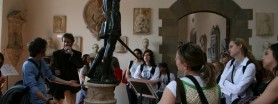 breathtaking. Seeing the work in person was such an experience. The colors on the wall are more vibrant than any reproduction reveals, and the expressions on the faces of Christ and the Twelve Apostles are so packed with emotion. Despite the mishap, seeing the Last Supper was by far the best part of the entire trip. Finally we headed over to the Castello Sforzesco to see Da Vinci’s Sala delle Asse. After a very long day we finally caught a train back to Perugia. Overall the trip was a success and provided a much-needed perspective on many of Leonardo’s magnificent works.
breathtaking. Seeing the work in person was such an experience. The colors on the wall are more vibrant than any reproduction reveals, and the expressions on the faces of Christ and the Twelve Apostles are so packed with emotion. Despite the mishap, seeing the Last Supper was by far the best part of the entire trip. Finally we headed over to the Castello Sforzesco to see Da Vinci’s Sala delle Asse. After a very long day we finally caught a train back to Perugia. Overall the trip was a success and provided a much-needed perspective on many of Leonardo’s magnificent works.
Post by Melanie Riall
Photos: 1. The Class in the Uffizi in Florence, 2. Students playing with Leonardo’s wood reproductions, 3. Melanie Riall spinning on the Milan bull in the Galleria.


